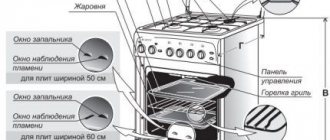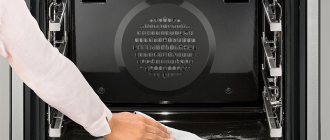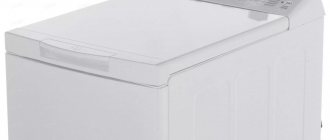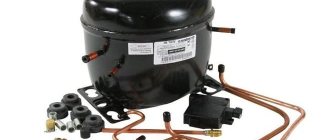Kitchens have a common characteristic feature - functionality. In this relatively small room there are all types of household communications and a lot of equipment. The center of the kitchen has always been the oven or its prototype, the stove, and only then the hob appeared. Nowadays, the oven and stove are increasingly becoming separate devices, and the importance of the second has grown. But at the same time, technology is developing, and new oven cooking functions are becoming available to customers. Thus, the quality and variety of the modern human diet is increasing. Buying an oven for your kitchen is not a matter of one hour. The dimensions of the equipment are directly dependent on the kitchen set, and if it is not there or has not yet been assembled, then the overall picture will have to be “assembled” in the process. Installing the oven is simple in terms of the structure of actions, but you will have to carefully read the instructions and carefully carry out the connection.
Types of oven
Ovens are distinguished according to several classifications:
- type of accommodation;
- management method;
- source of energy.
Depending on the type of placement, there are free-standing and built-in ovens. Some options are placed anywhere, but next to the power source. For those being installed, special furniture sections are provided. Based on the control method, a distinction is made between autonomous and dependent ovens. The second subtype only works in conjunction with the hob, and adjustments are made through one interface. Autonomous ones have become increasingly common in recent years. The third classification option is by energy source. The devices are divided into gas and electric models. The former remain in demand due to the prevalence of the energy carrier, but cannot heat the chamber evenly. Electric ovens are the most popular at the moment. Users select a certain temperature, and the device, in turn, maintains it with high accuracy and at a stable level.
Connection instructions step by step
The procedure for connecting an electric built-in oven to electricity by creating a separate line:
- The input AV switches off in the switchboard.
- Automatic protection is connected.
- The line cable is pulled to the panel, it should be connected there to the RCD or RCBO.
- Next, observing the polarity, connect the wires to the outlet box, if the oven has a cord with a plug, or directly to the power cable of the electric oven, to its terminals.
Choosing an installation location
Whatever the design, all options are installed in the central part of the wall, closer to the edge, and also away from the corners of the room. The stove is placed where the hood is planned. In addition, take into account the rule of the working triangle with vertices in the form of a stove, refrigerator and sink. Autonomous ovens are usually installed under the same autonomous cooking zone, so the triangular shape criterion is relevant for all oven models. In this case, the rule can be modified by replacing the sink or refrigerator with a work surface or dining table. These are not all the nuances. Maintain a safe distance between the oven and other objects. For example, the distance from flammable materials: oil, towels, curtains. The distance from water sources is ideally 1.5 meters or more, and the permissible minimum is 60 cm. Leave 60-70 cm of free space above the hob surface of the stove. Electric ovens are mounted next to a grounded power outlet.
Rules for installing and preparing a furniture niche
Installation is carried out between sections of the kitchen working surface, under its countertop or in a niche designed for this purpose in a set or a separate module. The wall is designed to match the parameters of the oven, and is ordered or purchased taking into account all dimensions and installation method. The segment suitable for installing the oven is disconnected from the rest, if such a fastening is present. After meeting all the criteria and taking into account aspects of the compatibility of furniture and ovens, all that remains is to prepare the furniture niche. In this sense, you should start with protection against surges in the power network. Then grounding is done. They also leave gaps between the oven and the walls of the furniture. To maintain an acceptable level of ventilation, at least 40-50 mm are left between the back wall of the niche and the oven, and a margin on the sides is 50 mm or more. In addition to ventilation, the lower part of the furniture should be protected from heating: a rise of 90-100 mm is needed.
Important points:
- The connection to the electrical panel must be made through a separate circuit breaker.
- Do not directly connect copper and aluminum wires.
- It is forbidden to connect electrical wires by twisting.
Installation of a gas cabinet is only permissible in the presence of a specialist.
Safety first
A domestic gas leak is an extremely dangerous situation that can lead to serious poisoning, explosion, property damage and death. This happens infrequently, and the cause of accidents is usually common - errors in connecting devices and violation of their operating conditions.
The set of rules and safety standards boils down to ensuring that all connections of gas pipes and appliances are sealed; the number of such components must be kept to a minimum. Having studied the rules for installing gas household appliances, even a home craftsman can cope with this task.
High-quality equipment is not cheap, so you should not skimp on properly connecting the device. Installation work will cost approximately 2,000 rubles including materials
During the work, it is necessary to follow the procedure for connecting the equipment, use suitable materials, and strictly follow the instructions. Upon completion of work, all connections are checked. Compliance with the rules will allow you to get the desired result - a safely installed and connected gas oven.
When installing a built-in gas oven with your own hands, the most common violation is the use of a tee for a gas pipe to which the hob is already connected.
Inexperienced craftsmen believe that if it works with a water supply system, then it will work for a gas supply system. The result is three joints that must be carefully sealed.
According to the rules, connecting the oven and hob should be done separately, connecting each device to its own pipe. The number of connections in this case will be reduced to two.
In practice, using a tee can be quite safe. If the threads are properly sealed, it does not really matter whether two connections are made when connecting or three.
You cannot connect gas appliances through a tee without using a dielectric gasket and a shut-off valve for each individual consumer.
But this method contradicts the existing rules for installing a gas oven. If during an inspection a gas service representative discovers such a tee, the owners of the apartment or house will face a completely legal fine.
Therefore, from the very beginning it is necessary to take this point into account in order to connect the oven correctly. In addition, a dielectric gasket should be used, and a shut-off valve should be installed for each gas-consuming appliance.
DIY installation
Self-installation is possible if you have knowledge and experience working with electrical circuits. They are almost always mounted in the lower tier, but autonomous products without a hob are installed in different places, provided that the gaps are maintained. Manufacturers take into account the complexity of this moment and provide cameras at a distance of 5 cm from the back and sides, and 10 cm from the bottom. Special furniture sections, in turn, have 10-centimeter legs. During the installation process, they first check the capabilities of the installation site, the serviceability of parts, connections, and communication points. Set up a system of electrical wires and make grounding. Sometimes you have to look for sockets with special parameters. Installation of the device proceeds after preparing the working tools and the installation site. The device is fixed only with factory fastenings.
Checking electrical wiring and connection
Without checking the quality of the wiring, further actions are prohibited. The first step is to find out the resistance level. Next, check the cross-section of the electrical wires, because it must correspond to the power of the oven. Next, the quality of the cores is determined. Typical system needs result in the presence of a grounding structure. Then they look at the circuit breaker, which reacts to failures and overloads. The current level for operation of this element is selected, depending on the declared power of the device. The built-in device is connected using a thick copper wire. In general, it is recommended to make an additional branch. New sockets of a non-standard configuration may be needed. The relevant information is indicated in the technical passport. The more powerful the oven model, the more likely it is that a special connector will be required. Screw terminal blocks should be used to connect the wires.
Installing and fixing the oven
For installation into the set you will need a painting knife, a fork, insulation, a drill and a Phillips screwdriver. As for the installation location, for stand-alone devices without a hob, an option with a second tier is possible, but it is better to place the device in the bottom row. Install equipment only in a level space that has been verified by the building level. The connection has a clear algorithm. They start by replacing the aluminum cable with a copper cable with three wires. Replacement is carried out from the device to the shield itself. For a device consuming 3-3.5 kW, you need a wire with a cross-section of 2.5 mm² and a 25 ampere circuit breaker. If the energy consumption is higher, then a core with a cut area of 4 mm² and a 40 ampere circuit breaker. The wires are connected to a 3-phase outlet. For houses with double cable, the shield is grounded. If the oven has a two-pin connector on the back, then the grounding on it is a separate screw - you can work with a simple wrench.
Connecting wires
All manipulations when connecting wires, installing automation, sockets, wiring are carried out with the circuit breaker turned off (in the switchboard it must be clicked into the off position).
An example of creating a power cord. If there is an outlet and the electric oven has a power of up to 3.5 kW (can be marked P = 3.5 kW), then it is enough to buy a piece of PVA 3 × 2.5 and a collapsible plug for it for 16 A. The length can be selected according to needs, the main thing is that there is no tension.
In the plug, the yellow (yellow-green) wire goes to the ground connector, brown (phase) and blue (zero) are connected to the rest. At the same time, for household appliances, polarity does not matter, but it must be taken into account when connecting wiring to the switchboard, automation (L - phase, N - working zero). "Earth" (PE) must always correspond to its place in the plug and terminals.
How to properly prepare a new oven for use
After installation, the device should be discarded of anything left after unpacking. Even before turning on for the first time, the oven must warm up to +25 °C, so if the appliance was cold, then leave the doors open. Subsequently, the stove requires calcination. It should be heated together with all grates, baking sheets and everything that is included and intended for indoor use. Then the oven is turned off, opened and left to cool completely. After a few hours, the inside of the oven, including all its elements, is washed with non-abrasive products. First they work with a sponge, and then wipe everything dry with a rag or thick cloth. For normal calcination, 2-3 hours at maximum temperature are enough - as a result, technical materials and liquids will be eliminated. Simultaneously with calcination, it does not hurt to use the convection or top heating mode.
Warming up is also used:
- After washing.
- After glass replacement.
Cable
If, when purchasing an oven, a cable with a plug is included, then it is already designed for the power of the device. But often there is no power cord, and this situation is standard, since different connection options are used and the cable that will be included may turn out to be unnecessary.
Cable selection:
- for low-moving wiring from the panel (open or in a groove) to the socket hole or outlet - monolithic cable VVGng (NYMng);
- The oven may be portable, meaning movable segments of the power cord (from the outlet or wiring) may be required. For such areas you need a multi-core cable. Although monolithic can also be used: it is usually copper, has a certain degree of flexibility and is less prone to fractures, unlike aluminum. Here the user must evaluate the frequency of movement of the electric oven. PVA is suitable for the role of stranded wire.
Features and rules for installing a gas oven with a hob
To connect a gas oven, you do not need permission from the gas service, but at the same time, there is a fine for incorrect installation. The optimal installation option looks like this: first, the shut-off valve is released, and a triple fitting is screwed onto its outer pipe. Screw on using lubricated tow. Next, taps are installed on two free branches of the fitting, just like a fitting on a pipe. All joints are then checked for tightness and tightness. They are coated with soapy water and then the central tap is opened. If bubbles appear, then all manipulations begin again. Even barely noticeable bubbles are enough. When everything is done perfectly, proceed to connecting the cabinet. It is connected by a line to the tap. A gasket with grease is placed in the union nut. The nut is tightened tightly, but so much so that it does not put pressure on the connection.
The best material for flexible hose is a corrugated metal hose.
Tips and tricks for choosing an oven
The leader in consumer preference is electric models. The latter provide more options regarding temperature conditions and cooking methods. When choosing, you can use standard criteria: ease of use, efficiency, safety, appearance, compatibility with the environment and environmental friendliness. Gas ovens have a significant drawback: you often have to check the condition of the dishes from below, as they dry out from one-sided exposure. As for the dependent/autonomous division, the size of the room is important in this regard. Dependent ones are in a sense more universal, but autonomous ones are suitable if there is a separate hob, and an additional one will be superfluous due to the lack of another hood. In terms of the built-in/free-standing parameter, none of the options has a clear advantage. The first type is better for design, and the second can be represented by compact options.
Regardless of the type of device, you need to pay attention to the presence of a smart interface, a built-in microwave, and automatic cleaning capabilities. The buyer should be interested in the presence of Let's Taste and StreamFunction. Operating savings depend on energy efficiency.











